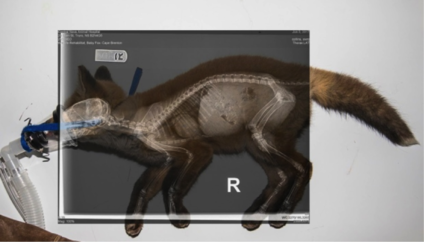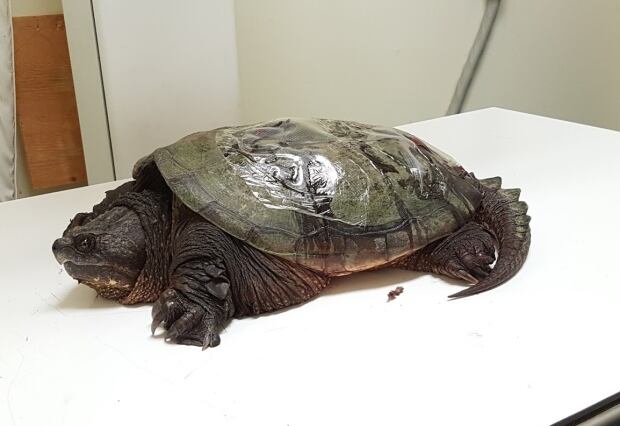
About 200 animals a year are brought to the Cobequid Wildlife Rehabilitation Centre for treatment after being struck by vehicles. One was this red fox, which survived. (Murdo Messer/Cobequid Wildlife Rehabilitation Centre)
There are few species in Nova Scotia that drivers haven't crushed with their tires, bludgeoned with their bumpers or walloped with their windshields.
Snapping turtles, bald eagles and even bobcats and bears have all been felled by the automobile — and some species are feeling the strain on their population.

It can take some animals a while to recover after they've been struck by a vehicle. (Murdo Messer/Cobequid Wildlife Rehabilitation Centre)
"We can't just keep hitting them on the road and think it's not a problem," said Wanda Baxter, the project manager for Watch for Wildlife, a group that educates people about how to drive more carefully and avoid striking animals.
Baxter said population loss due to vehicle strikes can seriously harm vulnerable species.
Helene Van Donick is a veterinarian and founder of the Cobequid Wildlife Rehabilitation Centre. (Murdo Messer/Cobequid Wildlife Rehabilitation Centre)
At the Cobequid Wildlife Rehabilitation Centre in Brookfield, N.S., about 200 animals a year are brought in for treatment after being struck by a car.
"It's our No. 1 reason for admitting things here," said Helene Van Doninck, a wildlife vet who founded the centre. "It's very, very common. We deal with birds, small mammals, we deal with reptiles."

Promptly removing roadkill can help keep animals like bald eagles from flying onto a road. (Murdo Messer/Cobequid Wildlife Rehabilitation Centre)
She said vehicle collisions are harming species like snapping turtles, which already have a small population. The turtles like to lay their eggs on the side of the road, putting them and their young at risk.
Snapping turtles are particularly vulnerable to the effects of human activity and natural events, according to the province's Department of Natural Resources.

This snapping turtle needed to have his shell repaired after being run over. (Murdo Messer/Cobequid Wildlife Rehabilitation Centre)
Bob Petrie, the department's director of wildlife, says exactly how a population is affected by vehicle collisions varies from species to species.
"Vehicle collisions, while they're regrettable, wouldn't necessarily be a conservation threat for some species, but for other species, for example the endangered mainland moose, collisions would be a much more serious threat to the species — simply because there are fewer of them."

Deer are by far the most common animal killed on Nova Scotia roadways. (Wanda Baxter/Watch for Wildlife)
The Department of Transportation says on average there are 14,000 vehicle collisions a year in Nova Scotia. From 2011 to 2015, about 500 to 600 of those collisions involved vehicles striking animals, usually deer. The department has not finished compiling numbers for 2016 and 2017.
Those numbers come from police reports forwarded to the Transportation Department, but they only include incidents in which damage to a vehicle is more than $2,000 or in which someone is injured.
The Department of Natural Resources also tracks the number of animals hit by cars, but only if someone phones the department and tells workers what they hit.

Bald eagles are often hit by cars when they swoop down to feed on the remains of a dead animal in the road. (Murdo Messer/Cobequid Wildlife Rehabilitation Centre)
DNR says from 2012 to 2017, 1,265 deer were struck by cars — the most of any one species. During the same period, 24 bears, 20 coyotes, 19 barred owls, 16 moose, 14 raccoons, 13 bobcats and 11 bald eagles were reported hit. That's just a sampling of the animals killed by vehicles, according to the department.
However, both Baxter and Van Doninck say those figures don't reflect the actual number of animals being struck.

Van Doninck says some animals can survive their run ins with cars if they get veterinary help. This snapping turtle was lucky enough to get that help and recover. (Murdo Messer/Cobequid Wildlife Rehabilitation Centre)
They believe most people do not report hitting small animals like skunks, porcupines or most birds, so the numbers stay low.
Baxter and Van Doninck want the government to do more to track what's being hit and where so changes can be made to keep people and animals safe.

This groundhog had to have its arm immobilized to help it heal. (Murdo Messer/Cobequid Wildlife Rehabilitation Centre)
The Department of Transportation says it's already doing that. Mike Croft, manager of traffic engineering and road safety, said collision data tells them where many animals are getting hit.
Croft said the department has already made changes to protect people and wildlife, including the installation of underpasses that wildlife can use to get around Highway 104 near Oxford and in the Antigonish area.

Few people report the small animals that they hit, like this porcupine. Wildlife groups want people to report any animals they strike so the Department of Natural Resources can gather more accurate data. (Murdo Messer/Cobequid Wildlife Rehabilitation Centre)
Wildlife fencing has also been built around Bridgewater to keep animals from reaching the road.
Brush and trees along some highways are also cleared to help people spot animals before they get into the road, and road signs warn people of animals such as deer and moose.
Why the province wants your trail camera photos of deer and bears
Halifax councillor wants ban on feeding wildlife in the city

Litter on the side of the road often attracts mice and they attract predators like owls. When owls fly low to catch their food they can get clipped by a car, like this one did. (Murdo Messer/Cobequid Wildlife Rehabilitation Centre)
"It's hard to identify what we call hotspots because when we plot the collisions and look at them on our highway system, they're everywhere," said Croft. "I mean, in Nova Scotia there is a lot of wildlife. There's a lot of deer."
In order to avoid animals, both wildlife groups and the province suggest people drive the speed limit and pay attention to the road.
Baxter also suggests not throwing litter out of a car because that can draw animals to the side of the highway.
